9th edition is coming, with Warhammer 40k set to be transformed. Games Workshop have been posting details of the new edition every day, with Twitch streams and Warhammer Community articles giving us a tantalising look into the new edition.
Since their announcement stream, Games Workshop has been doing daily posts and videos on the new edition and the changes it will bring. We’ve been covering off on some of these during the week with some of the big updates around Terrain and Vehicles, and while we’ve repeated some of those articles here, we’ve also added new notes tying things together so if you already read those once, there’s some new notes and content in there that you might find insightful.
For reference, here’s a full list of articles published this week:
Tanks are back on track!
Having a blast!
Terrain rules and line of sight
Taking flight
You can also check out last week’s round-up here.
Aircraft
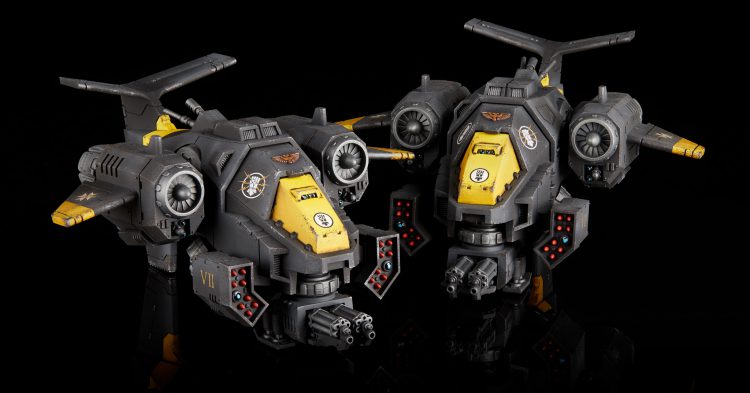
9th edition has new and updated rules for aircraft, continuing to make use of the AIRCRAFT keyword added in the Spring 2019 FAQ, and formalising the list of units this applies to in the rulebook. The ones in the current group of codexes are outlined in the list below, and the Forge World vehicles getting the keyword will get their update in the new Indexes releasing with 9th edition.
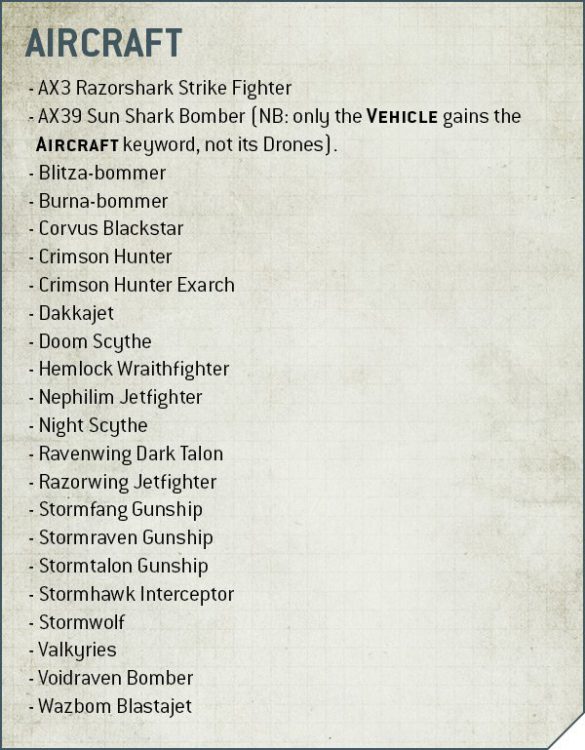
Aircraft have a host of new rules associated with them. A lot of these focus on movement and are refinements of the FAQ rules, but one major change is that Aircraft can move off the battlefield now and return later on. We now know how that works – They return to the table as Strategic Reserves. Normally, this lets a unit set up within 6″ of a battlefield edge, but Aircraft can instead choose to set up anywhere that is more than 9″ from an enemy unit, essentially letting them “deep strike.” Aircraft can’t declare a charge on the turn they arrive from Strategic Reserves.
Notes: What’s particularly interesting here is the Strategic Reserves bit. We’ve heard the GW rules team mention having units outflank before in preview discussions, which suggests that there will be other units and methods for arriving from reserves, and it looks like doing so lets you set up anywhere that is wholly within 6″ of a battlefield edge. That’s an interesting wrinkle for protecting units and dropping in on your opponent.
Additionally, movement for Aircraft and other units has been cleaned up significantly. Aircraft can move over enemy units in the Movement phase, and Aircraft can make a normal move or Advance even if they are within Engagement range of enemy models. Movement around aircraft is also easier – models can move over Aircraft bases with any kind of move, plus they can move or Advance if they are only within Engagement range of an enemy Aircraft. They can also ignore Aircraft when performing a Heroic Intervention, consolidating or piling in, unless they have FLY.
Notes: This cleans up a lot of awkwardness around Aircraft and using their bases to block movement. It wasn’t super-common, but a few lists had success with it in 8th edition before the FAQ adjusted how Flyer bases worked. The big shift compared to the FAQ version is how engagement is treated – other than for attackers with fly, Aircraft are basically completely ignored in the fight phase, which tidies up some gamey things you could do with positioning them to hamper consolidations. It’s also important to note that this is phrased as “making a normal move” for both the Aircraft and the units in Engagement range – you don’t have to Fall Back, and seem to be free to go about your life after trying to thunder hammer an aircraft out of the sky.
The other thing to watch for here is how Aircraft interact with units in Engagement range in the Fight phase. Currently the way these rules are worded, you could move into Engagement range with a winged Daemon Prince (or other model with FLY) in the Movement phase, then activate them to fight in the Fight phase without ever having charged. We’ll have to see how these rules interact once we have the full rules for Aircraft.
Tanks – Vehicles & Monsters
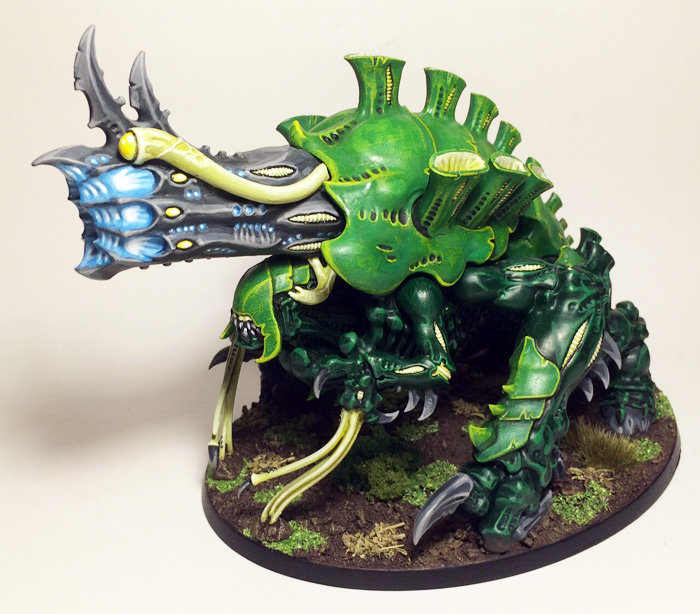
There are some big changes coming, with vehicles and monsters losing the penalty for moving and shooting heavy weapons and being able to fire at enemies they’re locked in combat with. The former is a major change: the -1 hit penalty for moving and firing heavy weapons will only apply to INFANTRY in 9th Edition, and immediately makes rules like Power of the Machine Spirit and the Death Guard Inexorable Advance on Helbrutes redundant. The latter is made possible by a new rule, Big Guns Never Tire.
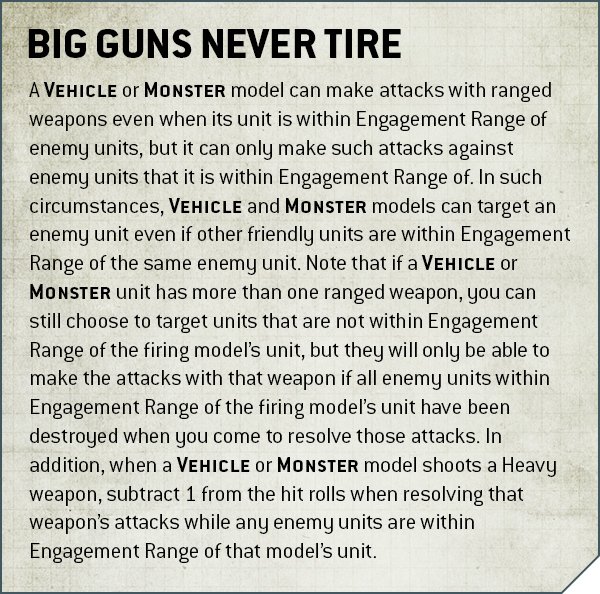
What’s changed with tanks and monsters in the new edition?
Quite a few things. Some are inherent to tanks and monsters; others are things that have changed in the game that will affect them. Tanks being able to shoot in combat is the biggest thing, as Vehicles and Monsters in Engagement range of enemy units can choose to shoot their weapons at models within Engagement range and can also declare shooting out of combat (see our Ruleshammer post on this for more details). There are some restrictions, such as a -1 to hit penalty when shooting heavy weapons against targets in engagement range. Blast weapons also cannot be used against targets within Engagement range.
Note: This applies to all VEHICLES and MONSTERS, including Dreadnoughts and Walkers. This supports “all-rounders” that have both melee and shooting capability and makes vehicles and monsters that have good melee value but are forced to take a ranged weapon much more valuable – their ranged weapons more than just a liability once they get into combat. It also makes heavy flamer sponsons significantly better. TheChirurgeon is already daydreaming about Helbrutes with heavy flamers in their twin close combat weapon arms, but Knights also benefit greatly from this.
Other rules that will benefit vehicles:
- Units are apparently able to fight people on the next floor up if you can reach them. Fighting in buildings and terrain has changed; stairs will not protect you. Note: It’s not entirely clear yet how this will work, but it’s good to hear that there’s a plan for it, at least. This wasn’t really cleared up in the terrain update, either.
- Terrain changes will also help vehicles, such as being able to hug LOS blocking terrain and let them get across the battlefield. Note: See “Terrain,” Below.
- The opportunity to outflank and move from off the board can also help vehicles. Stu gave an example of Repulsor Executioners flanking and taking out a target previously hidden from LOS. Note: We now know this involves being placed on the table wholly within 6″ of a table edge, per the note about Strategic Reserves in “Aircraft,” above. Depending on how tanks are able to do this and the costs involved, this could be huge.
Based on playtesting, which forces get the biggest boost?
Tyranids for sure. Imperial Guard as well. Being able to use things like pintle-mounted weapons in melee will make them viable. Basically anything with a mechanized force or a bunch of monsters. Sisters of Battles with Immolators will be happy.
Is there room for specialization?
There’s room for both generalists and specialized units. Specialists give the option to be great at one thing but face threats that you might lack the tools for, while generalists better at everything. Stu said the designers are repeatedly told “how do we give people choices that matter” in all stages of play from army building to tactics. The goal is to make the game more about choices and less about pure random luck. If you built a model with a generalist configuration because you thought it looks cool you’ll no longer be penalized for making a sub-optimal configuration.
Do you expect to see less bubble wrapping?
Castling is less effective now that missions are more dynamic and vehicles can hold their own in combat. Having mobile weapon platforms that can claim objectives and hunt down threats will be more beneficial. Tanks are designed to be more like hammers that smash enemies instead of glorified artillery pieces. The game will be less static combat thanks to new missions and more terrain.
What challenges will vehicles face in the new edition?
The big challenge will be that with the changes to terrain it will be much harder to get a clear view of the battlefield. No choosing a place to sit and hit everything. Have to move a lot more. Vehicles will not be able to enter certain pieces of terrain, requiring infantry and encouraging combined arms forces.
Notes: Terrain is going to be a critical part of play in 9th edition with the smaller battlefields we’ll be playing on. At 44″x60″, a model with a 12″ move and even a 36″ range is likely to be able to get in range of anything it wants to shoot, so having terrain that blocks Line of Sight is going to be critical to having a balanced experience.
Will we start to see more vehicle- or monster-heavy armies?
Yes. 9th Edition “throws all the jigsaw pieces in the air” with the changes to Command Points, detachments, etc. Goal is to have “more best things” instead of one optimal solution. Games Workshop wants great games together with different lists. Orks Speed WAAAGHs, Tyranid Monster armies, tank companies, etc. “Any army you like the look of can compete.”
Blast Weapons
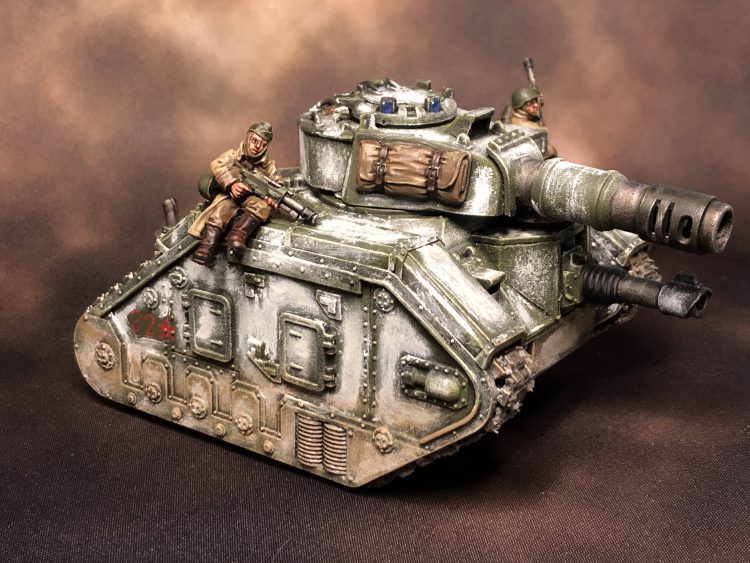
Another major change for 9th edition is rules for Blast Weapons. While removing templates from 8th edition sped things up quite a bit, it also left a lot to be desired with regard to how those weapons actually operated. In 9th edition, a number of these weapons have been designated as Blast Weapons, and these have special rules on how they work. There are 174 of them including relics, and they’re all noted in the back of the 9th edition core rulebook, which includes Barbed Stranglers, Deathstrike Missiles, D-Cannons, Sqiug Launchas, and Phlegm Bombardment.
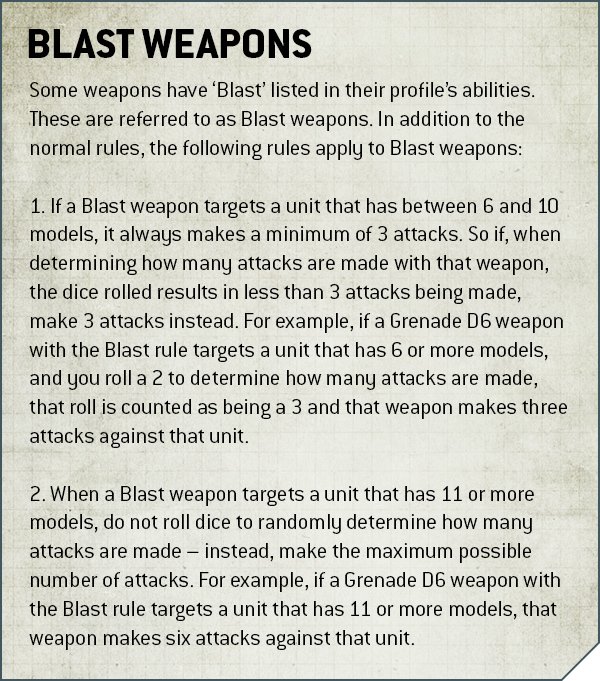
The big thing to note for Blast Weapons is that, against target units with 6-10 models, you do a minimum of 3 attacks when rolling for the number of attacks that weapon makes, and if it has 11+, you automatically do the maximum attacks. This makes Blast weapons significantly better against high model-count units, and helps return these horde-clearing options to prominence.
Note: While the full list is yet to be seen, we think a good bet for it is any gun that had the “Large Blast” rule will get the Blast rule. This means that one likely candidate is the Knights’ Rapid Fire Battle Cannon, which suddenly becomes much better if it has a chance to throw out 12 shots at larger units.
Terrain
Overall Statement:
The goal is to make terrain an equal player in the game, “equal to a third army.” Terrain rules are what has changed the most from last edition. These rules are meant to be more meaningful and interactive. Line of Sight will be cut down a lot more. 40K has been very deadly and units need to be able to hide, particularly in first turn. The intent is to make the game more based on movement and have a dynamic feel and create a justification for things like outflanking.
Also: More cool terrain and models are on the way. (GREGNOTE: Why do they bother, when Moon Base Klaisus already exists)
There are Four Terrain Categories in 9th Edition
- Hills (literal physical objects) – these retain their rules from 8th edition as “considered to be part of the battlefield” and offer no protection or benefits
- Obstacles (barrier, walls) – offer cover, which will usually mean +1 to saving throws against ranged weapons for INFANTRY, BEASTS, and SWARMS if the obstacle is between you and the firing unit
- Area Terrain (clearly defined terrain bases like woods, swamps, ruins) – the benefits of these will depend on their Terrain Traits (see below)
- Buildings (units) – fortifications, usually
Terrain Traits
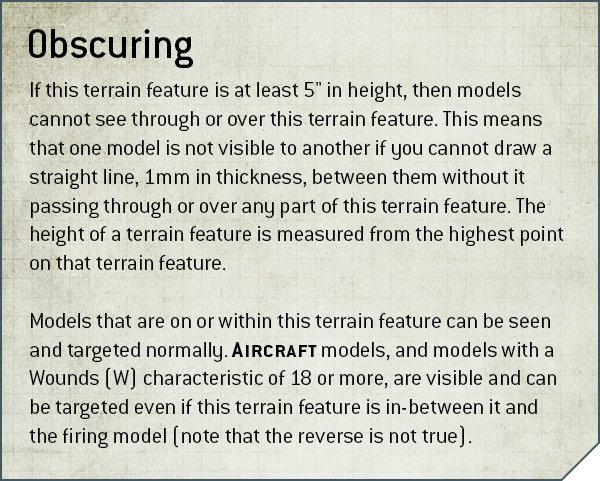
Terrain traits are new to this edition and have a big impact. There are “10 to 12” of them. Some examples:
- Obscuring: If terrain is more than 5″ tall then it blocks Line of Sight even if you can physically see through it. The footprint blocks LOS.
- This doesn’t apply if the model behind it is an AIRCRAFT or has 18+ Wounds, so you need to fully block LOS if you want to hide a Knight, Mortarion, Magnus, or some other massive war machine.
- This also doesn’t apply to models INSIDE the terrain, who can be freely targeted (but get its other benefits).
- Note 1: This means that line of sight is more abstracted in 9th edition than 8th, and you don’t have to worry so much about windows on ruins any more. Previously, some events like the ITC had ruled that the first floor of ruins were LOS-blocking to get around the fact that kits like Games Workshop’s Sector Imperialis were lousy with open windows that made them poor cover in 8th.
- Note 2: The exemption for 18W models means there’s still plenty of use for large, LOS-blocking terrain features with no windows to go in the middle of the battlefield. “NOVA Ls” may still see plenty of play in 9th, depending on how people feel about blocking LOS to Knights.
- GREGNOTE: This has horrifying repercussions for Goonhammer’s favorite terrain set, Moon Base Klaisus, as basically none of the terrain in it will block LoS.
- Wings Note: This has moderately interesting implications for big L-blocks on square bases, as are currently very popular, as if you consider the tall walls and the base part of the same terrain element, then technically the big, flat square base also blocks LOS to things behind it, which is weird. It’s possible we’ll get this cleared up once we have the full rules, or that events will house-rule only the wall section itself to be obscuring.
- TheChirurgeon’s Note: This is easily fixed by not having the square bases, which is something I’ve seen pretty frequently anyways – only half the NOVA terrain Ls have square footprints and the PTT terrain footprint is non-existent. Likewise the LGT MDF terrain doesn’t have a big square footprint, either. I don’t think this will be a big deal to play RAW.
- Dense Cover – likely gives a to hit modifier. See below.
- Light Cover – Gives +1 to saves against incoming ranged attacks
- Heavy Cover – Gives +1 to saves against incoming melee attacks
- Defensible
- Breachable
- Scaleable
- Exposed Position
Note: There are examples of these up on Warhammer Community in the cover article and how they apply to Ruins and Munitorum Armoured Containers. Based on how they’re applied, we believe that Breachable refers to some models being able to walk through walls in the same way that INFANTRY can currently do so in 8th edition and Scaleable likely refers to being able to climb the sides of a piece of terrain, so models can climb on top of a Munitorum Armoured Container. Exposed Position likely refers to not receiving the benefit of cover in an area, i.e. you get no bonus when you stand on top of an Armoured Container. We still aren’t sure what Defensible means.

In the stream they mentioned that there are three types of cover: Light, Heavy, and Dense, where light and heavy are about offering protection and “Dense” is about being difficult to see through. They mentioned that cover can offer either to hit or armor save modifiers.
Note: This almost certainly means that Dense Cover will give models -1 to hit at targets that are receiving its benefits. Additionally, it’s worth noting here that 9th edition will include the rule that models always hit on a 6 with ranged attacks in addition to its cap on modifiers to hit at +/- 1.
Wings Notes: Heavy cover is a huge incentive to be on the attack in melee, because when you charge you get the bonus and the target doesn’t. Nicely thematic in that it makes assault a great way to clear out positions. Ground floor windows not blocking LOS for units within the cover is going to be a total headache for ITC players for a bit.
On stream they showed nine examples and what traits they would have. These use common language. GW products have predefined traits. For example GW Sector Imperialis ruins have the Obscuring, Scaleable, Breachable, Light Cover, and Defensible traits. Armoured Containers have Scaleable, Light Cover, and Exposed Position.
On the stream they mentioned that the rulebook will have guidelines on setting up terrain and building battlefields, with tons of example battlefields shown. How much, how it should be set up. 10-12 pieces of terrain. LOS blockers in the center, no big pieces on the edges. The article has some photo examples of this. They’ve tried to show where and how to set up terrain to create a fair game.
Part of game start to define traits for terrain on the table. Note: We’ve seen this mentioned before in the first set of previews/information – Games will have a “Define Terrain” step where players specify what each piece of terrain is and what traits it has before the game begins, removing any ambiguity.
These are designed to be clear and robust rules that can be universally applied. Also “future-proof concept” and expandable.
At its core it’s ‘pretty straightforward’ – Obscuring or not, type of cover, and then any additional rules. Most of the time you either hide behind it or it gives you cover. Plus other characterful things ahead of time.
As the game develops new terrain traits will be added.
Recommendation: One scenery piece per 12” square, then combined with picture examples. Playtesting team provided examples of ‘ideal battlefields’ and then the Studio team recreated. Balanced terrain concept; provide less terrain and it’s too sparse that might be one-sided, etc. Generic standard for pickup games where people just want to play some games.
GREGNOTE: This also doesn’t mesh well with Moon Base Klaisus, which includes nowhere near the recommended amount of terrain.
Can terrain be destroyed?
The short answer is “no.” Only buildings (things taken as part of your army with statlines) can be destroyed.
Do you expect TOs to have to adopt this system?
Yes. Hopefully what we’ve given them is more guidance than we’ve ever done. “If you want people to come to your event and have a good time this is what your board should look like.” Playtesting group is full of veteran players with experience running huge events or participating. Note: We’ve already seen comments from the ITC to this effect, so plan on these being the terrain rules used in competitive play.
What Wasn’t Mentioned: Interactions at different heights
They’ve previously mentioned that 9th edition will fix issues with “gamey” things like a Carnifex not being able to reach targets higher up on ruins or pieces of terrain. It’s not yet clear how this will be handled or how they’ve fixed it. They mentioned units fighting “one floor up if they’re able to reach” but this is still pretty vague.
GREGNOTE: Also inexplicably and disrespectfully not mentioned: Moon Base Klaisus
Our Thoughts
We got a lot more meat this week as it relates to the rules of 9th edition, and a lot more to think about with regard to how vehicles and terrain will work. The cover changes bring a much-needed level of abstraction to the terrain rules in 40k that will help ensure terrain is functional while requiring fewer flat, featureless walls that act as pure line of sight blockers with no other function. We’ve seen some complaints in the wild over these changes around players deciding to use ruins that are “4.9 inches high” or not being able to shoot over cover from a higher vantage point; these fundamentally miss the point. The height of terrain is not nearly as important as determining the terrain’s traits before the game or event, and you can houserule or create workarounds for different heights as you need.
For casual players, it’s likely we’ll see major expansions on these rules when we see updated rules for Cities of Death and fortification-focused scenarios like Stronghold Assault or Planetstrike. Cities of Death rules will need to handle elevation a bit more thoroughly but it’s not an issue that comes up in tournament play anyways.
It seems that there will be more reason to take vehicles of all types in 9th edition. It still remains to be seen how effective they’ll be at accomplishing this; being able to hide and move them more certainly helps. Though the vehicles that were playable in 8th ended up either having significant protection against threats such as heavy negative modifiers to be hit or an invulnerable save, or they packed an obscene amount of offensive output for their cost, or both. This is in some ways a result of 8th edition rules shaping how vehicles were designed; will there be an incentive to use older vehicles that don’t fall into these categories? We hope so, because T’au Hammerheads are cool models.
Have any questions or feedback? Drop us a note in the comments below or email us at contact@goonhammer.com.


